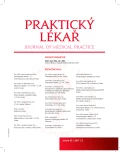-
Medical journals
- Career
Functional disorders of the musculoskeletal system
Authors: R. Poděbradská 1,2; M. Šarmírová 1
Authors‘ workplace: Masarykova univerzita, Brno Fakulta sportovních studií Katedra podpory zdraví Vedoucí: MUDr. Kapounková Kateřina, Ph. D. 1; Rehabilitace Lipová-lázně Primář: MUDr. Jiří Poděbradský 2
Published in: Prakt. Lék. 2017; 97(5): 198-201
Category: Reviews
Overview
The musculoskeletal system is the most frequent source of pain within the organism, and at the same time, pain is the most frequent symptom of a musculoskeletal system disorder, especially regarding its function. Functional disorders of the musculoskeletal system also represent one of the most frequent causes of incapacity to work, as they mostly affect working age patients. The first steps of a patient experiencing pain in the musculoskeletal system usually lead to a general practitioner’s office. Due to the fact that the issue of rehabilitation and functional disorders of the musculoskeletal system is not lectured in the necessary scope at many medical faculties, we are hereby presenting an essential introduction into the functional disorders of the musculoskeletal system and their prevention, diagnostics, and options of therapy for a general practitioner’s practice.
Keywords:
functional disorders –musculoskeletal system – levels of motion management – physical therapy
Sources
1. Bačová E, Bačová L. Poruchy jemné motoriky v ordinaci praktického lékaře. Prakt. Lék. 2016; 96(3): 125–127.
2. Balkó I, Kabešová H, Balkó Š, Kohlíková E. Příčiny kloubní hypermobility a její vztah ke sportovní činnosti. Česká kinantropologie 2014; 18 : 26–35.
3. Dobeš M. Diagnostika a terapie funkčních poruch pohybového systému (manuální terapie) pro fyzioterapeuty: učební text k základnímu kurzu. Horní Bludovice: Domiga 2011.
4. Karolyi M, Komenda M, Janoušová R, Schwarz D. Finding overlapping termis in medical and health care curriculum using test mining metrods: Rehabilitation representation – a proof of concept. Mefanet J 2016; 4(2): 71–77.
5. Kolář P, Lewit K. Význam hlubokého stabilizačního systému v rámci vertebrogenních obtíží. Neurol praxi 2005; 5 : 270–275.
6. Kolář P, a kol. Rehabilitace v klinické praxi. Praha: Galén 2009.
7. Lewit K. Manipulační léčba v myoskeletální medicíně (5. přepracované vydání). Praha: Sdělovací technika ve spolupráci s Českou lékařskou společností J. E. Purkyně 2003.
8. Poděbradský J, Poděbradská R. Fyzikální terapie – manuál a algoritmy. Praha: Grada Publishing 2009.
9. Trävell JG, Simons DG. Myofascial pain and dysfunction the trigger point manual the upper extremities. Baltimore: Williams and Wilkins 1982.
10. Vařeka I, Dvořák R. Posturální model řetězení poruch funkce pohybového systému. Rehabil fyz Lék 2001; 8(1): 33–37.
11. Véle F. Kineziologie: Přehled klinické kineziologie a patokineziologie pro diagnostiku a terapii poruch pohybové soustavy. Praha: Triton 2006.
12. Vojta V, Peters A. Vojtův princip. Překlad 3. vydání. Praha: Grada Publishing 2010.
Labels
General practitioner for children and adolescents General practitioner for adults
Article was published inGeneral Practitioner

2017 Issue 5-
All articles in this issue
- Honey and health
- Functional disorders of the musculoskeletal system
- Modern technology and its application in home-based rehabilitation
- Prostate cancer and secondary prevention in general practitioners’ offices
- Health literacy of seniors and its impact on health and the use of health services
- Selected problems in female patients with relapsing-remitting sclerosis multiplex
- European guide on good practices for Patient Blood Management
- General Practitioner
- Journal archive
- Current issue
- Online only
- About the journal
Most read in this issue- Functional disorders of the musculoskeletal system
- Selected problems in female patients with relapsing-remitting sclerosis multiplex
- Honey and health
- European guide on good practices for Patient Blood Management
Login#ADS_BOTTOM_SCRIPTS#Forgotten passwordEnter the email address that you registered with. We will send you instructions on how to set a new password.
- Career

